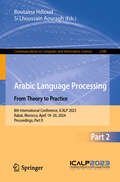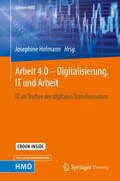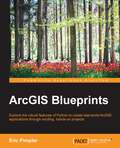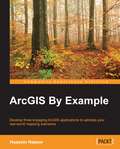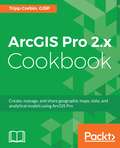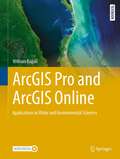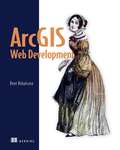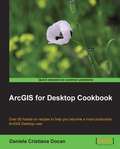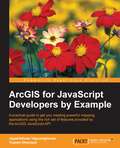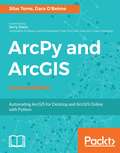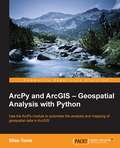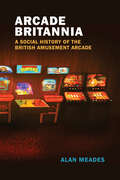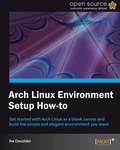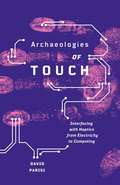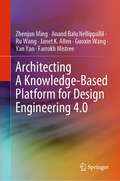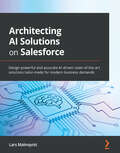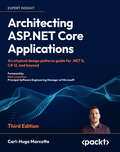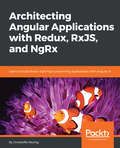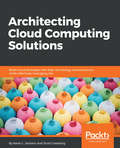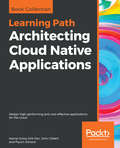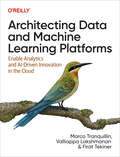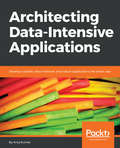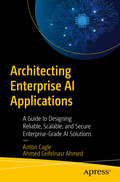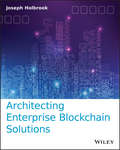- Table View
- List View
Arabic Language Processing: 8th International Conference, ICALP 2023, Rabat, Morocco, April 19–20, 2024, Proceedings, Part II (Communications in Computer and Information Science #2340)
by Boutaina Hdioud Si Lhoussain AouraghThis two-volume set, CCIS 2339 and CCIS 2340, constitutes the refereed proceedings of the 8th International Conference on Arabic Language Processing, ICALP 2023, held in Rabat, Morocco, during April 19–20, 2024. The 30 full papers and 11 short papers presented in these two volumes were carefully reviewed and selected from 107 submissions. The papers are organized in the following topical sections: Part I: Learning Arabic and dialectal and Sentiment Analysis; Advancements in Deep Learning for Arabic Language Processing: Generation, Translation, and QA. Part II: Linguistic Resources for Arabic NLP; Various analysis of Arabic.
Arbeit 4.0 – Digitalisierung, IT und Arbeit: It Als Treiber Der Digitalen Transformation (Edition HMD)
by Josephine HofmannAktuelle und spannende Fachbeiträge zur Arbeitswelt der Zukunft.<P><P> Diskutiert Arbeitsgestaltung und Qualifizierung im Zeitalter der Digitalisierung.<P> Liefert differenzierte Einblicke zu IT-Einsatz und Wirkung in verschiedenen Branchen.<P> Die Digitalisierung transformiert die Arbeitswelt in vieler Hinsicht: Arbeitsplätze werden zunehmend mobil und flexibel, Arbeitsprozesse durch Algorithmen gesteuert, Roboter sind die neuen „Kollegen“ in der Industrie und im Dienstleistungssektor. Dieser Band der „Edition HDM“ erörtert viele zentrale Fragen rund um die Transformation der Arbeitswelt von heute und morgen. In ihren Beiträgen über den Einfluss der massiven Digitalisierung auf unterschiedliche Branchen und Arbeitsbereiche diskutieren die Autorinnen und Autoren diverse Aspekte wie: • den Einfluss der Digitalisierung im Versandhandel und auf die Wissensarbeit. • die Interaktion von Mensch und Roboter in der Fabrik 4.0.• den Wert der menschlichen Arbeitsleistung in der Zukunft.• die Anforderungen an Qualifizierung.• die Möglichkeiten für Mitarbeiter, die Arbeit in der vernetzten Wirtschaft 4.0 proaktiv mitzugestalten. Unter der Herausgeberschaft von Josephine Hofmann, Leiterin des Competence Center Business Performance Management am Fraunhofer IAO in Stuttgart, entsteht so ein Sammelband, der sich als Teil der aktuellen Debatte um die digitale Transformation der Arbeitswelt versteht. Nicht nur Wissenschaftler erhalten neue Denkanstöße für ihre Forschung, auch Entscheider in Wirtschaft und Politik sowie Verantwortliche in den Bereichen Bildung, Fortbildung und Personalentwicklung können aus der Lektüre des Buches wertvolle Erkenntnisse über die Arbeit von heute und die Gestaltung der zunehmend digitalisierten Arbeitswelt von morgen gewinnen.
ArcGIS Blueprints
by Eric PimplerExplore the robust features of Python to create real-world ArcGIS applications through exciting, hands-on projects About This Book * Get to grips with the big world of Python add-ins and wxPython in GUI development to implement their features in your application * Integrate advanced Python libraries, ArcPy mapping, and data access module techniques to develop a mapping application * Construct a top-notch intermediate-to-advanced project by accessing ArcGIS Server and ArcGIS Online resources through the ArcGIS REST API using a project-based approach Who This Book Is For If you have prior experience building simple apps with ArcGIS and now have a fancy for developing a more challenging and complex desktop application in ArcGIS, then this book is ideal for you. What You Will Learn * Automate the creation of creative output data visualizations including maps, charts, and graphs * Explore ways to use the ArcPy Mapping module and Data-driven Pages to automate the creation of map books in your own project * Develop applications that use the Plotly platform and library to create stunning charts and graphs that can be integrated into ArcGIS Desktop * Build tools that access REST services and download data to a local geodatabase * Design, build, and integrate advanced GUIs with wxPython and ArcGIS Desktop in ArcGIS * Get clued up about constructing applications that export data to Google Earth Pro to automate time-consuming complex processes * Maximize the access of ArcGIS Server and ArcGIS Online using the ArcGIS REST API with Python In Detail This book is an immersive guide to take your ArcGIS Desktop application development skills to the next level It starts off by providing detailed description and examples of how to create ArcGIS Desktop Python toolboxes that will serve as containers for many of the applications that you will build. We provide several practical projects that involve building a local area/community map and extracting wildfire data. You will then learn how to build tools that can access data from ArcGIS Server using the ArcGIS REST API. Furthermore, we deal with the integration of additional open source Python libraries into your applications, which will help you chart and graph advanced GUI development; read and write JSON, CSV, and XML format data sources; write outputs to Google Earth Pro, and more. Along the way, you will be introduced to advanced ArcPy Mapping and ArcPy Data Access module techniques and use data-driven Pages to automate the creation of map books. Finally, you will learn advanced techniques to work with video and social media feeds. By the end of the book, you will have your own desktop application without having spent too much time learning sophisticated theory. Style and approach This is an easy-to-follow, project-based guide that guides you through the whole ArcGIS theme with practical, real-world examples and a systematic approach.
ArcGIS By Example
by Hussein NasserDevelop three engaging ArcGIS applications to address your real-world mapping scenarios About This Book * Design, build and run ArcGIS applications using ArcObjects SDK * Extend ArcGIS objects and use add -ins to deploy applications on top of ArcGIS * An example-centric practical guide to help you understand mapping scenarios with ArcGIS Who This Book Is For If you are an application developer and wish to enhance your skills for the GIS domain with ArcGIS, then this book is for you. Previous experience with ArcGIS is not required. What You Will Learn * Use essential ArcGIS code to query geodatabases * Communicate with ArcGIS maps, with the help of critical designing and optimisation tips * Highlight and interact with objects on your map * Query ArcGIS geodatabases with related data to display your information on ArcGIS * Edit your underlying geodatabase * Explore strategies for the adaptation of various types of spatial analysis techniques into the GIS framework * Analyze tools for Geographical Information Systems and remote sensing * Experience ArcGIS's advanced tools for manipulation of shapefiles and geodatabases In Detail ArcGIS is a geographic information system (GIS) for working with maps and geographic information. It is considered the turnkey solution to creating and sharing interactive maps. ArcGIS is designed to work the way you work. With nothing to install and set up, ArcGIS helps you make your work productive from day one. The book covers the design and development of three ArcGIS applications to guide the readers in crafting their own GIS solution as per their requirements. The book begins by giving you a refresher on the concepts of ArcGIS. Without wasting any time, you'll begin with developing your first ArcGIS application. You will be developing a cell tower analysis tool. Following this, you will be guided through mapping signal strength and real - time manoeuvring in your GIS system. You will then move on to the second application of the book: a restaurant mapping system. The application will allow tourists to browse restaurants on a map, according to their preferences. Next, you will learn how to work with reviews and ratings and also cover some of the advanced searching options offered by ArcGIS. You will then make use of advanced ArcObjects to develop your third application: an excavation planning manager. The book will conclude by teaching you how work out excavation cost calculations and also saving and retrieving your excavation designs. Style and approach The book offers an enhanced way of learning ArcGIS, through the design and development of three applications throughout its length. In addition to this the book also covers features that you can add to your application as you develop each one covered in the book.
ArcGIS Pro 2.x Cookbook: Create, manage, and share geographic maps, data, and analytical models using ArcGIS Pro
by Tripp CorbinCreating and Sharing Maps and Data using ArcGIS Pro Key Features Leverage the power of ArcGIS to build beautiful 2D and 3D maps. Work with ArcGIS to analyze and process data. Extend the power of ArcGIS to ArcGIS Online to create and edit content. Book Description ArcGIS is Esri's catalog of GIS applications with powerful tools for visualizing, maintaining, and analyzing data. ArcGIS makes use of the modern ribbon interface and 64-bit processing to increase the speed and efficiency of using GIS. It allows users to create amazing maps in both 2D and 3D quickly and easily. If you want to gain a thorough understanding of the various data formats that can be used in ArcGIS Pro and shared via ArcGIS Online, then this book is for you. Beginning with a refresher on ArcGIS Pro and how to work with projects, this book will quickly take you through recipes about using various data formats supported by the tool. You will learn the limits of each format, such as Shapefiles, Geodatabase, and CAD files, and learn how to link tables from outside sources to existing GIS data to expand the amount of data that can be used in ArcGIS. You'll learn methods for editing 2D and 3D data using ArcGIS Pro and how topology can be used to ensure data integrity. Lastly the book will show you how data and maps can be shared via ArcGIS Online and used with web and mobile applications. What you will learn Edit data using standard tools and topology Convert and link data together using joins and relates Create and share data using Projections and Coordinate Systems Access and collect data in the field using ArcGIS Collector Perform proximity analysis and map clusters with hotspot analysis Use the 3D Analyst Extension and perform advanced 3D analysis Share maps and data using ArcGIS Online via web and mobile apps Who this book is for GIS developers who are comfortable using ArcGIS, and are looking to increase their capabilities and skills, will find this book useful.
ArcGIS Pro and ArcGIS Online: Applications in Water and Environmental Sciences (Springer Textbooks in Earth Sciences, Geography and Environment)
by William BajjaliThis textbook serves as a practical guide for undergraduate and graduate students in geology, hydrology, ecology, and environmental sciences, teaching them applied GIS techniques. Presented as a step-by-step tutorial across seventeen chapters, the book starts with the fundamentals of GIS and progresses to real-life examples from geology and water resources. The focus is on ESRI's ArcGIS Pro, covering various tools for spatial, geostatistical, network, and 3-D analysis. Additionally, it explores ArcGIS Online and working with web apps like Web Map, StoryMaps, and GEO App.GIS applications, especially in water and environmental problem-solving, are rapidly growing worldwide. The demand for GIS experts utilizing spatial analysis in environmental science remains high. This textbook equips users with the necessary knowledge to become effective mappers and spatial analysts in the fields of environment, geosciences, and water resources, employing the latest state-of-the-art methodology.Each chapter provides exercises and supplementary materials available for download on SpringerLink, along with additional links for further learning opportunities.
ArcGIS Web Development
by Rene RubalcavaSummaryArcGIS Web Development is an example-rich tutorial designed to teach developers to use the ArcGIS JavaScript API to build custom GIS web applications.About the TechnologyNow you can unshackle your GIS application from a workstation! Using the ArcGIS JavaScript API, developers can build mobile and web-based maps and applications driven by ArcGIS data and functionality. Experienced ArcGIS developers will find that the familiar development environment provides a smooth transition to the web. Web developers new to GIS will be pleased by how easily they can apply their existing skills to GIS applications.Purchase of the print book includes a free eBook in PDF, Kindle, and ePub formats from Manning Publications.About the BookArcGIS Web Development is an example-rich guide that teaches you to use the ArcGIS JavaScript API to build custom GIS web applications. The book begins with easy-to-follow examples that introduce readers to the ArcGIS JavaScript API and show how you can apply simple customizations. As the book progresses, you'll explore a full-scale, web-mapping application. By the end you will be able to build web apps that have features you'd ordinarily expect to find only in dedicated GIS applications.Written for web developers familiar with JavaScript and basic GIS concepts. Experience with ArcGIS is helpful, but not necessary.What's InsideBuild web-based GIS applicationsCustomize the ArcGIS Javascript API toolsBring ArcGIS data to the webCreate secure logins for mobile app usersAbout the AuthorRene Rubalcava is the cofounder of SmartGeoTech, Inc., a GIS development company specializing in Esri technologies.Table of ContentsPART 1 ARCGIS JAVASCRIPT FOUNDATIONGIS as a toolIntroducing core API conceptsWorking with the REST APIPART 2 SAMPLE USE CASEBuilding an applicationDeveloping a custom data-collection applicationBuilding a desktop browser applicationAdvanced techniquesAPPENDICESSetting up your environmentDojo basicsConfiguring a proxy
ArcGIS for Desktop Cookbook
by Daniela Cristiana DocanThis book is a good companion to get you quickly acquainted with everything you need to increase your productivity with the ArcGIS Desktop. It would be helpful to have a bit of familiarity with basic GIS concepts. If you have no previous experience with ArcGIS, this book will still be helpful for you because it will help you catch up to the acquainted users from a practical point of view.
ArcGIS for JavaScript Developers by Example
by Jayakrishnan Vijayaraghavan Yogesh DhanapalA practical guide to get you creating powerful mapping applications using the rich set of features provided by the ArcGIS JavaScript API About This Book * Unshackle your GIS application from a workstation! Get running with three major web mapping projects covering all the important aspects of the ArcGIS JavaScript API. * Set a strong foundation for the ArcGIS JavaScript API and modular coding with dojo. * Gain a crystal clear understanding of the ArcGIS JavaScript, and become skilled in creating exciting and interesting geospatial apps. Who This Book Is For This book is for JavaScript developers who wish to develop amazing mapping applications using the rich set of features provided by the ArcGIS JavaScript API, but more than that, a spatial frame of mind will help a long way. What You Will Learn * Find out what you need to develop a web mapping application in the ArcGIS environment * Get to know about the major features provided by the ArcGIS JavaScript API * See the coding best practices to develop modular dojo-based JavaScript applications * Get to grips with writing custom re-usable dojo modules using dojo and esri modules and dijits * Understand how to use various ArcGIS data sources and other open geospatial data available on the web * Discover how to query spatial data and get the best out of your data using analytical techniques * Master the art of rendering your map beautifully and create wonderful data visualizations using non-map objects such as charts * Grasp how to create secure and scalable web maps In Detail The book starts by explaining the basics of the ArcGIS web mapping ecosystem. The book walks you through the development of six major applications, covering a wide variety of topics such as querying, rendering, advanced data visualization and performing map analytics. It also emphasizes on writing modular code using pure dojo, which is the preferred platform for developing web GIS applications using ArcGIS JavaScript API. By the end of the book, you will have gained enough practical experience to architect a robust and visually powerful mapping application using the API. Style and approach This is a practical, hands-on guide on using the ArcGIS JavaScript API to develop mapping applications. It is packed with three progressively challenging and diverse projects that explain the plethora of API and dojo topics.
ArcPy and ArcGIS - Second Edition
by Silas Toms Dara O'BeirneUse Python modules such as ArcPy, ArcREST and the ArcGIS API for Python to automate the analysis and mapping of geospatial data. About This Book • Perform GIS analysis faster by automating tasks. • Access the spatial data contained within shapefiles and geodatabases and transform between spatial reference systems. • Automate the mapping of geospatial analyses and production of map books. Who This Book Is For If you are a GIS student or professional who needs an understanding of how to use ArcPy to reduce repetitive tasks and perform analysis faster, this book is for you. It is also a valuable book for Python programmers who want to understand how to automate geospatial analyses and implement ArcGIS Online data management. What You Will Learn • Understand how to integrate Python into ArcGIS and make GIS analysis faster and easier. • Create Python script using ArcGIS ModelBuilder. • Learn to use ArcGIS online feature services and the basics of the ArcGIS REST API • Understand the unique Python environment that is new with ArcGIS Pro • Learn about the new ArcGIS Python API and how to use Anaconda and Jupyter with it • Learn to control ArcGIS Enterprise using ArcPy In Detail ArcGIS allows for complex analyses of geographic information. The ArcPy module is used to script these ArcGIS analyses, providing a productive way to perform geo-analyses and automate map production. The second edition of the book focuses on new Python tools, such as the ArcGIS API for Python. Using Python, this book will guide you from basic Python scripting to advanced ArcPy script tools. This book starts off with setting up your Python environment for ArcGIS automation. Then you will learn how to output maps using ArcPy in MXD and update feature class in a geodatabase using arcpy and ArcGIS Online. Next, you will be introduced to ArcREST library followed by examples on querying, updating and manipulating ArcGIS Online feature services. Further, you will be enabling your scripts in the browser and directly interacting with ArcGIS Online using Jupyter notebook. Finally, you can learn ways to use of ArcPy to control ArcGIS Enterprise and explore topics on deployments, data quality assurances, data updates, version control, and editing safeguards. By the end of the book, you will be equipped with the knowledge required to create automated analysis with administration reducing the time-consuming nature of GIS. Style and approach The book takes a pragmatic approach, showing ways to automate repetitive tasks and utilizing features of ArcPy with ArcGIS Pro and ArcGIS online.
ArcPy and ArcGIS – Geospatial Analysis with Python
by Silas TomsIf you are a GIS student or professional who needs an understanding of how to use ArcPy to reduce repetitive tasks and perform analysis faster, this book is for you. It is also a valuable book for Python programmers who want to understand how to automate geospatial analyses.
Arcade Britannia: A Social History of the British Amusement Arcade (Game Histories)
by Alan MeadesThe story of the British amusement arcade from the 1800s to the present.Amusement arcades are an important part of British culture, yet discussions of them tend to be based on American models. Alan Meades, who spent his childhood happily playing in British seaside arcades, presents the history of the arcade from its origins in traveling fairs of the 1800s to the present. Drawing on firsthand accounts of industry members and archival sources, including rare photographs and trade publications, he tells the story of the first arcades, the people who made the machines, the rise of video games, and the legislative and economic challenges spurred by public fears of moral decline. Arcade Britannia highlights the differences between British and North American arcades, especially in terms of the complex relationship between gambling and amusements. He also underlines Britain&’s role in introducing coin-operated technologies into Europe, as well as the industry&’s close links to America and, especially, Japan. He shows how the British arcade is a product of centuries of public play, gambling, entrepreneurship, and mechanization. Examining the arcade&’s history through technological, social, cultural, biographic, and legislative perspectives, he describes a pendulum shift between control and liberalization, as well as the continued efforts of concerned moralists to limit and regulate public play. Finally, he recounts the impact on the industry of legislative challenges that included vicious taxation, questions of whether copyright law applied to video-game code, and the peculiar moment when every arcade game in Britain was considered a cinema.
Arch Linux Environment Setup How-To
by Ike DevolderEach task expresses a specific task for setting up an Arch Linux environment. The recipe as a solution is a carefully organized set of instructions to perform the task as efficiently as possible and a discussion on how to apply the solution in different situations. "Arch Linux Environment Set-up" How to is for people wanting to dig deep into a Linux system. By the end of the book you will have basic knowledge how a Linux system is built up, how it boots and a general idea of how it is working. The book also assumes you already know what partitioning is and if you need dual booting you already have some experience with that. For people only trying out Arch Linux the author would suggest following this guide inside a virtual machine.
Archaeologies of Touch: Interfacing with Haptics from Electricity to Computing
by David ParisiA material history of haptics technology that raises new questions about the relationship between touch and media Since the rise of radio and television, we have lived in an era defined increasingly by the electronic circulation of images and sounds. But the flood of new computing technologies known as haptic interfaces—which use electricity, vibration, and force feedback to stimulate the sense of touch—offering an alternative way of mediating and experiencing reality. In Archaeologies of Touch, David Parisi offers the first full history of these increasingly vital technologies, showing how the efforts of scientists and engineers over the past three hundred years have gradually remade and redefined our sense of touch. Through lively analyses of electrical machines, videogames, sex toys, sensory substitution systems, robotics, and human–computer interfaces, Parisi shows how the materiality of touch technologies has been shaped by attempts to transform humans into more efficient processors of information. With haptics becoming ever more central to emerging virtual-reality platforms (immersive bodysuits loaded with touch-stimulating actuators), wearable computers (haptic messaging systems like the Apple Watch&’s Taptic Engine), and smartphones (vibrations that emulate the feel of buttons and onscreen objects), Archaeologies of Touch offers a timely and provocative engagement with the long history of touch technology that helps us confront and question the power relations underpinning the project of giving touch its own set of technical media.
Architecting A Knowledge-Based Platform for Design Engineering 4.0
by Janet K. Allen Farrokh Mistree Anand Balu Nellippallil Yan Yan Zhenjun Ming Ru Wang Guoxin Wang"Design Engineering for Industry 4.0 (DE4.0) represents the 'human-cyber-physical view of the systems realization ecosystem “that is necessary to accommodate the drivers of Industry 4.0 (IoX) and provide an open ecosystem for the realization of complex systems. Seamless integration of digital threads and digital twins throughout the product design, the development and fulfillment lifecycle; the ability to accommodate diverse and rapidly changing technologies; and the mechanisms to facilitate the creation of new opportunities for the design of products, processes, services, and systems are some of the desired characteristics of DE4.0."Jiao, R., Commuri, S. Panchal, J., Milisavljevic-Syed, J, Allen, J.K., Mistree, F. and Schaefer, D., "Design Engineering in the Age of Industry 4.0," ASME Journal of Mechanical Design, 143(7), 070801, 25 pages.In keeping with the Design Engineering 4.0 construct the authors describe architecting a computer platform to support human designers make decisions associated with the realization of complex engineered systems. The platform is designed to facilitate end-to-end digital integration, customization and personalization, agile collaboration networks, open innovation, co-creation and crowdsourcing, product servitization and anything-as-a-service.Recognizing that simulation models are abstractions of reality the authors opt for a satisficing strategy instead of an optimization strategy. They include fundamentals and then describe tools for architecting a knowledge-based platforms for decision support. Challenges associated with developing a computational platform for decision support for the realization of complex engineered systems in the context of Design Engineering 4.0 are identified. Constructs for formulating design decisions (e.g., selection, compromise, and coupled decisions), knowledge modelling schemes (e.g., ontologies and modular templates), diagrams for designing decision workflows (e.g., the PEI-X diagram), and some analytical methods for robust design under uncertainty are presented. The authors describe integrating the knowledge-based platform to architect a cloud-based platform for decision support promoting co-design and cloud-based design communication essential for mass collaboration and open innovation for Design Engineering 4.0.This book is a valuable resource for researchers, design engineers, and others working on pushing the boundary of digitized manufacturing to include Design Engineering 4.0 principles in designing products, processes, and services.
Architecting AI Solutions on Salesforce: Design powerful and accurate AI-driven state-of-the-art solutions tailor-made for modern business demands
by Lars MalmqvistUse Salesforce's out-of-the-box and advanced integration-based AI capabilities to architect modern enterprise solutions on sales, service, marketing, and commerce clouds to drive digital innovation for your clientsKey FeaturesGet up to speed with Salesforce's AI features and capabilities to meet ever-evolving client needsGet expert advice on key architectural decisions and trade-offs when designing AI-driven Salesforce solutionsIntegrate third-party AI services into applications that modernize your solutionsBook DescriptionThe ever-increasing need for designing state-of-the-art solutions using AI features requires a sound understanding of a vast array of AI capabilities that help you to architect modern solutions. Salesforce Einstein is a set of services that allows seamless implementation of advanced artificial intelligence (AI) features while retaining the ability to cater to custom requirements for the business.This book will help you understand the business and technical benefits of building AI solutions and components available in Salesforce. As you work through a case study of a fictional company beginning to adopt AI in its Salesforce ecosystem, you'll learn how to configure and extend the out-of-the-box features on various Salesforce clouds, their pros, cons, and limitations. You'll also discover how to extend these features using on- and off-platform choices and how to make the best architectural choices when designing custom solutions. Later, you'll advance to integrating third-party AI services such as the Google Translation API, Microsoft Cognitive Services, and Amazon SageMaker on top of your existing solutions. This Salesforce book concludes by taking you through key architectural decisions and trade-offs that may impact the design choices you make.By the end of this book, you'll be able to architect Salesforce AI solutions to meet various customer requirements confidently.What you will learnExplore the AI components available in Salesforce and the architectural model for Salesforce EinsteinExtend the out-of-the-box features using Einstein Services on major Salesforce cloudsUse Einstein declarative features to create your custom solutions with the right approachArchitect AI solutions on marketing, commerce, and industry cloudsUse Salesforce Einstein Platform Services APIs to create custom AI solutionsIntegrate third-party AI services such as Microsoft Cognitive Services and Amazon SageMaker into SalesforceWho this book is forThis book is for existing and aspiring technical and functional architects, technical decision-makers working on the Salesforce ecosystem, and those responsible for designing AI solutions in their Salesforce ecosystem. Lead and senior Salesforce developers who want to start their Salesforce architecture journey will also find this book helpful. Working knowledge of the Salesforce platform is necessary to get the most out of this book.
Architecting ASP.NET Core Applications: An atypical design patterns guide for .NET 8, C# 12, and beyond
by Carl-Hugo MarcotteBackend design like you've never seen it before – a guide to building SOLID ASP.NET Core web apps that stand the test of time. Featuring more Minimal APIs, more testing, a new e-commerce project, and the modular monolith! Purchase of the print or Kindle book includes a free PDF eBook.Key FeaturesLearn multiple ways to organize your application code and become a more flexible ASP.NET Core developerExplore hands-on design patterns, learn architectural principles, and how to sidestep anti-patternsRefactor code toward modern application design, such as feature-based vertical slice and clean architectureBook DescriptionThis unique ASP.NET Core book will fill in the gaps in your REST API and backend designs. Learn how to build robust, maintainable, and flexible apps using Gang of Four (GoF) design patterns and modern architectural principles. This new edition is updated for .NET 8 and focuses exclusively on the backend, with new content on REST APIs, the REPR pattern, and building modular monoliths. You’ll start by covering foundational concepts like REST, the SOLID principles, Minimal APIs, dependency injection in .NET, and other ASP.NET Core 8 mechanisms. Then, you’ll learn to develop components using design patterns, including many from the GoF. Finally, you’ll explore organizing your application code with patterns that vary from layers to feature-oriented vertical slice designs, covering CQS and a deep dive into microservices along the way. A brand-new e-commerce project at the end of the book will tie it all together. This how-to guide will teach you how to assemble your own APIs from building blocks, to suit whatever real-world requirements you may have.What you will learnApply the SOLID principles for building flexible and maintainable softwareTest your apps effectively with automated tests, including black-box testingEmbark on mastering ASP.NET Core dependency injectionWork with GoF design patterns including strategy, decorator, facade, and compositeDesign REST APIs using Minimal APIs and ASP.NET Core MVCDiscover layering and the tenets of clean architectureUse feature-oriented techniques as an alternative to layeringExplore microservices, CQS, REPR, vertical slice architecture, and many more patternsWho this book is forThis book is for intermediate-level ASP.NET Core developers who want to improve their C# app code structure and API design skills. ASP.NET developers who want to modernize their knowledge and enhance their technical architecture skills will also like this book. It’s also a good refresher for those in software design roles with more experience looking to update their expertise. A good knowledge of C# programming and a basic understanding of web concepts is necessary to get the most out of this book, though some refreshers are included along the way.
Architecting Angular Applications with Redux, RxJS, and NgRx: Learn to build Redux style high-performing applications with Angular 6
by Christoffer NoringManage state in Angular to write high performing web apps by combining the power of Flux, RxJS, and NgRxKey Features- Learn what makes an excellent Angular application architecture- Use Redux to write performant, consistent Angular applications- Incorporate Reactive Programming principles and RxJS to make it easier to develop, test, and debug your Angular applicationsBook DescriptionManaging the state of large-scale web applications is a highly challenging task with the need to align different components, backends, and web workers harmoniously. When it comes to Angular, you can use NgRx, which combines the simplicity of Redux with the reactive programming power of RxJS to build your application architecture, making your code elegant and easy to reason about, debug, and test.In this book, we start by looking at the different ways of architecting Angular applications and some of the patterns that are involved in it. This will be followed by a discussion on one-way data flow, the Flux pattern, and the origin of Redux.The book introduces you to declarative programming or, more precisely, functional programming and talks about its advantages. We then move on to the reactive programming paradigm. Reactive programming is a concept heavily used in Angular and is at the core of NgRx. Later, we look at RxJS, as a library and master it. We thoroughly describe how Redux works and how to implement it from scratch. The two last chapters of the book cover everything NgRx has to offer in terms of core functionality and supporting libraries, including how to build a micro implementation of NgRx.This book will empower you to not only use Redux and NgRx to the fullest, but also feel confident in building your own version, should you need it.What you will learnUnderstand the one-way data flow and Flux patternWork with functional programming and asynchronous data streamsFigure out how RxJS can help us address the flaws in promisesSet up different versions of cascading callsExplore advanced operatorsGet familiar with the Redux pattern and its principlesTest and debug different features of your applicationBuild your own lightweight app using Flux, Redux, and NgRxWho this book is forIf you have been developing Angular applications and want to dive deeper into the Angular architecture with Redux, RxJS, and NgRx to write robust web apps, then this book is for you.
Architecting CSS: The Programmer’s Guide to Effective Style Sheets
by Martine Dowden Michael DowdenLeverage various CSS features in combination with popular architectures in order to bring your style sheets back under your control. While CSS is the primary technology used for building beautiful web user interfaces, the style sheet files themselves are often quite ugly; left chaotic and unstructured through lack of a consistent architectural approach. By addressing the structure of your style sheets in the same way that you do with code, see how it is possible to create style rules that are clean and easy to read. Dig deep into CSS fundamentals and learn how to use the available selectors to build powerful rules.You will learn how to use cascading, inheritance, pseudo-classes, pre-processors, and components to produce cleaner, DRY-er style sheets, and how to let these features work for you instead of leading you down the road of rule duplication and design inconsistencies. Embrace the clean, semantic HTML to make your code easier to read, while supporting accessibility and assistive technologies.Separate the concerns of layout and style to simplify dynamic theming and white labeling, making you a marketing hero. Once you've finished this book you will have an advanced knowledge of CSS structures and architectural patterns that will take the pain out of style sheets for you (and your coworkers), and help you implement designs faster and easier than ever before. What You'll LearnUnderstand the core CSS fundamentals of Inheritance, Cascading, and SpecificityWork with architecture and design patterns for better organization and maintenanceMaximize code reuse with CSS precompilersReview the strengths and weaknesses of popular architecture patterns Who This Book Is For Primarily for front-end web developers and UI designers and anyone who works with CSS, particularly if they find it cumbersome and inelegant. It’s also suitable for software architects and tech leads who are responsible for the maintainability of their code base.
Architecting Cloud Computing Solutions: Build cloud strategies that align technology and economics while effectively managing risk
by Kevin L. Jackson Scott GoesslingAccelerating Business and Mission Success with Cloud Computing.Key FeaturesA step-by-step guide that will practically guide you through implementing Cloud computing services effectively and efficiently. Learn to choose the most ideal Cloud service model, and adopt appropriate Cloud design considerations for your organization.Leverage Cloud computing methodologies to successfully develop a cost-effective Cloud environment successfully. Book DescriptionCloud adoption is a core component of digital transformation. Scaling the IT environment, making it resilient, and reducing costs are what organizations want. Architecting Cloud Computing Solutions presents and explains critical Cloud solution design considerations and technology decisions required to choose and deploy the right Cloud service and deployment models, based on your business and technology service requirements.This book starts with the fundamentals of cloud computing and its architectural concepts. It then walks you through Cloud service models (IaaS, PaaS, and SaaS), deployment models (public, private, community, and hybrid) and implementation options (Enterprise, MSP, and CSP) to explain and describe the key considerations and challenges organizations face during cloud migration. Later, this book delves into how to leverage DevOps, Cloud-Native, and Serverless architectures in your Cloud environment and presents industry best practices for scaling your Cloud environment. Finally, this book addresses (in depth) managing essential cloud technology service components such as data storage, security controls, and disaster recovery. By the end of this book, you will have mastered all the design considerations and operational trades required to adopt Cloud services, no matter which cloud service provider you choose. What you will learn Manage changes in the digital transformation and cloud transition process Design and build architectures that support specific business cases Design, modify, and aggregate baseline cloud architectures Familiarize yourself with cloud application security and cloud computing security threats Design and architect small, medium, and large cloud computing solutionsWho this book is forIf you are an IT Administrator, Cloud Architect, or a Solution Architect keen to benefit from cloud adoption for your organization, then this book is for you.Small business owners, managers, or consultants will also find this book useful. No prior knowledge of Cloud computing is needed.
Architecting Cloud Native Applications: Design high-performing and cost-effective applications for the cloud
by John Gilbert Kamal Arora Erik Farr Piyum ZonoozApply cloud native patterns and practices to deliver responsive, resilient, elastic, and message-driven systems with confidence Key Features Discover best practices for applying cloud native patterns to your cloud applications Explore ways to effectively plan resources and technology stacks for high security and fault tolerance Gain insight into core architectural principles using real-world examples Book Description Cloud computing has proven to be the most revolutionary IT development since virtualization. Cloud native architectures give you the benefit of more flexibility over legacy systems. This Learning Path teaches you everything you need to know for designing industry-grade cloud applications and efficiently migrating your business to the cloud. It begins by exploring the basic patterns that turn your database inside out to achieve massive scalability. You'll learn how to develop cloud native architectures using microservices and serverless computing as your design principles. Then, you'll explore ways to continuously deliver production code by implementing continuous observability in production. In the concluding chapters, you'll learn about various public cloud architectures ranging from AWS and Azure to the Google Cloud Platform, and understand the future trends and expectations of cloud providers. By the end of this Learning Path, you'll have learned the techniques to adopt cloud native architectures that meet your business requirements. This Learning Path includes content from the following Packt products: Cloud Native Development Patterns and Best Practices by John Gilbert Cloud Native Architectures by Erik Farr et al. What you will learn Understand the difference between cloud native and traditional architecture Automate security controls and configuration management Minimize risk by evolving your monolithic systems into cloud native applications Explore the aspects of migration, when and why to use it Apply modern delivery and testing methods to continuously deliver production code Enable massive scaling by turning your database inside out Who this book is for This Learning Path is designed for developers who want to progress into building cloud native systems and are keen to learn the patterns involved. Software architects, who are keen on designing scalable and highly available cloud native applications, will also find this Learning Path very useful. To easily grasp these concepts, you will need basic knowledge of programming and cloud computing.
Architecting Data and Machine Learning Platforms: Enable Analytics and AI-Driven Innovation in the Cloud
by Valliappa Lakshmanan Marco Tranquillin Firat TekinerAll cloud architects need to know how to build data platforms that enable businesses to make data-driven decisions and deliver enterprise-wide intelligence in a fast and efficient way. This handbook shows you how to design, build, and modernize cloud native data and machine learning platforms using AWS, Azure, Google Cloud, and multicloud tools like Snowflake and Databricks.Authors Marco Tranquillin, Valliappa Lakshmanan, and Firat Tekiner cover the entire data lifecycle from ingestion to activation in a cloud environment using real-world enterprise architectures. You'll learn how to transform, secure, and modernize familiar solutions like data warehouses and data lakes, and you'll be able to leverage recent AI/ML patterns to get accurate and quicker insights to drive competitive advantage.You'll learn how to:Design a modern and secure cloud native or hybrid data analytics and machine learning platformAccelerate data-led innovation by consolidating enterprise data in a governed, scalable, and resilient data platformDemocratize access to enterprise data and govern how business teams extract insights and build AI/ML capabilitiesEnable your business to make decisions in real time using streaming pipelinesBuild an MLOps platform to move to a predictive and prescriptive analytics approach
Architecting Data-Intensive Applications: Develop scalable, data-intensive, and robust applications the smart way
by Anuj KumarArchitect and design data-intensive applications and, in the process, learn how to collect, process, store, govern, and expose data for a variety of use casesKey FeaturesIntegrate the data-intensive approach into your application architectureCreate a robust application layout with effective messaging and data querying architectureEnable smooth data flow and make the data of your application intensive and fastBook DescriptionAre you an architect or a developer who looks at your own applications gingerly while browsing through Facebook and applauding it silently for its data-intensive, yet fluent and efficient, behaviour? This book is your gateway to build smart data-intensive systems by incorporating the core data-intensive architectural principles, patterns, and techniques directly into your application architecture.This book starts by taking you through the primary design challenges involved with architecting data-intensive applications. You will learn how to implement data curation and data dissemination, depending on the volume of your data. You will then implement your application architecture one step at a time. You will get to grips with implementing the correct message delivery protocols and creating a data layer that doesn’t fail when running high traffic. This book will show you how you can divide your application into layers, each of which adheres to the single responsibility principle. By the end of this book, you will learn to streamline your thoughts and make the right choice in terms of technologies and architectural principles based on the problem at hand.What you will learnUnderstand how to envision a data-intensive systemIdentify and compare the non-functional requirements of a data collection componentUnderstand patterns involving data processing, as well as technologies that help to speed up the development of data processing systemsUnderstand how to implement Data Governance policies at design time using various Open Source ToolsRecognize the anti-patterns to avoid while designing a data store for applicationsUnderstand the different data dissemination technologies available to query the data in an efficient mannerImplement a simple data governance policy that can be extended using Apache FalconWho this book is forThis book is for developers and data architects who have to code, test, deploy, and/or maintain large-scale, high data volume applications. It is also useful for system architects who need to understand various non-functional aspects revolving around Data Intensive Systems.
Architecting Enterprise AI Applications: A Guide to Designing Reliable, Scalable, and Secure Enterprise-Grade AI Solutions
by Anton Cagle Ahmed Mohamed AhmedThis book explores how to define, design, and maintain enterprise AI applications, exploring the impacts they will have on the teams who work with them. The book is structured into four parts. In Part 1: Defining Your AI Application, you are introduced to the dynamic interplay between human adaptability and AI specialization, the concept of meta systems, and the mechanics of prediction machines. In Part 2: Designing Your AI Application, the book delves into the anatomy of an AI application, unraveling the intricate relationships among data, machine learning, and reasoners. This section introduces the building blocks and enterprise architectural framework for designing multi-agent systems. Part 3: Maintaining Your AI Application takes a closer look at the ongoing life cycle of AI systems. You are guided through the crucial aspects of testing and test automation, providing a solid foundation for effective development practices. This section covers the critical tasks of security and information curation that ensure the long-term success of enterprise AI applications. The concluding section, Part 4: AI Enabled Teams, navigates the evolving landscape of collaborative efforts between humans and AI. It explores the impact of AI on remote work dynamics and introduces the new roles of the expert persona and the AI handler. This section concludes with a deep dive into the legal and ethical dimensions that AI-enabled teams must navigate. This book is a comprehensive guide that not only equips developers, architects, and product owners with the technical know-how of AI application development, but also delves into the broader implications for teams and society. What You Will Learn Understand the algorithms and processes that enable AI to make accurate predictions and enhance decision making Grasp the concept of metasystems and their role in the design phase of AI applications Know how data, machine learning, and reasoners drive the functionality and decision-making capabilities of AI applications Know the architectural components necessary for scalable and maintainable multi-agent AI applications Understand methodologies for testing AI applications, ensuring their robustness, accuracy, and reliability in real-world applications Understand the evolving dynamics of human-AI coordination facing teams in the new enterprise working environment Who This book Is For A diverse audience, primarily targeting enterprise architects, middle managers, tech leads, and team leads entrenched in the IT sector or possessing a tech-savvy background, including professionals such as digital marketers. Additionally, tech-savvy individual contributors—ranging from digital content creators and data analysts to administrators and programmers—stand to benefit significantly.
Architecting Enterprise Blockchain Solutions
by Joseph HolbrookDemystify architecting complex blockchain applications in enterprise environments Architecting Enterprise Blockchain Solutions helps engineers and IT administrators understand how to architect complex blockchain applications in enterprise environments. The book takes a deep dive into the intricacies of supporting and securing blockchain technology, creating and implementing decentralized applications, and incorporating blockchain into an existing enterprise IT infrastructure. Blockchain is a technology that is experiencing massive growth in many facets of business and the enterprise. Most books around blockchain primarily deal with how blockchains are related to cryptocurrency or focus on pure blockchain development. This book teaches what blockchain technology is and offers insights into its current and future uses in high performance networks and complex ecosystems. • Provides a practical, hands-on approach • Demonstrates the power and flexibility of enterprise blockchains such as Hyperledger and R3 Corda • Explores how blockchain can be used to solve complex IT support and infrastructure problems • Offers numerous hands-on examples and diagrams Get ready to learn how to harness the power and flexibility of enterprise blockchains!
